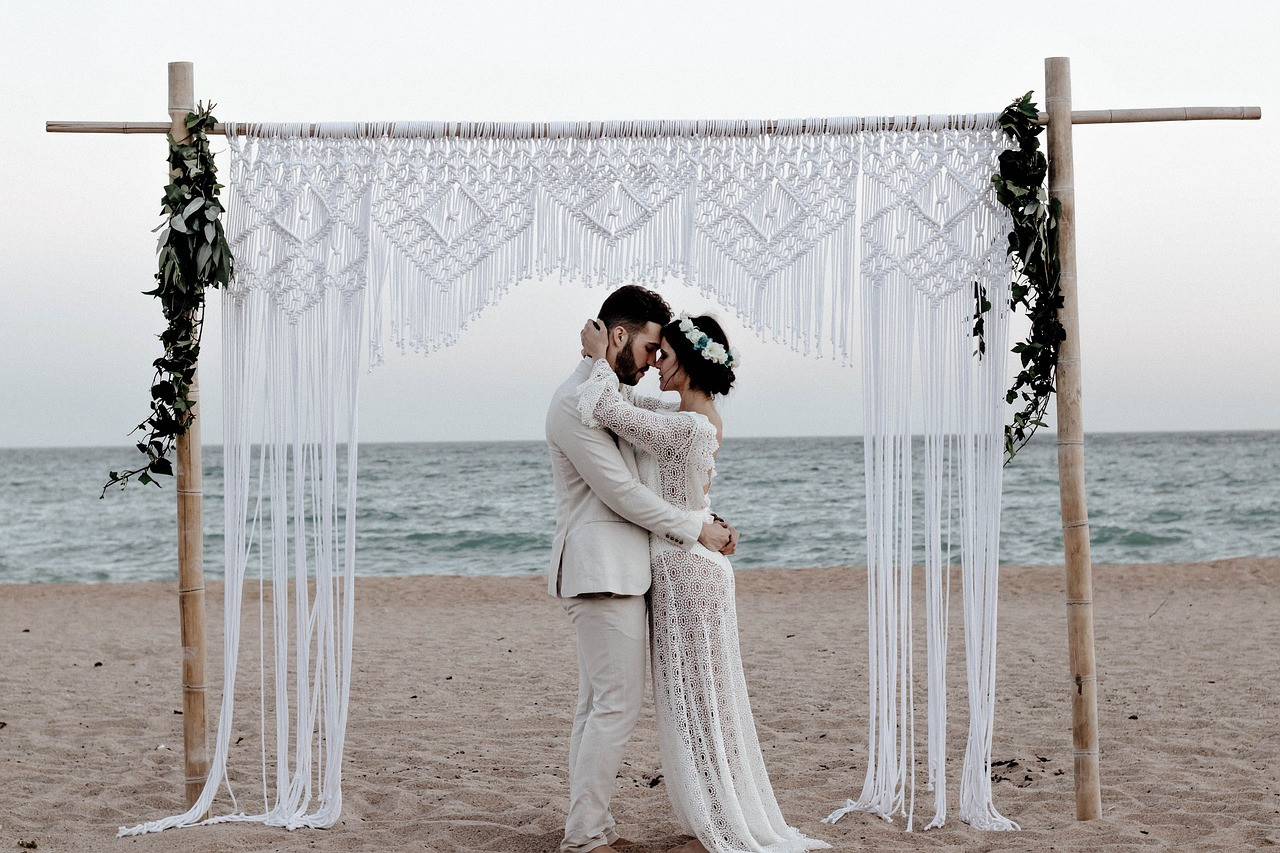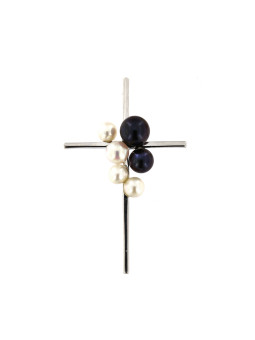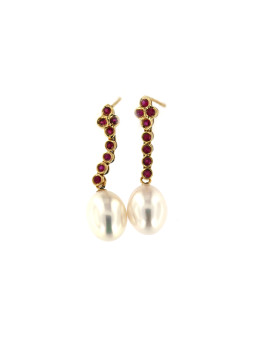Pearls: a necessary accent in every woman's jewelry box

Every woman must have pearl jewelry in her collection. Their quality depends on the source of the pearls, the method of formation and other quality factors. In this article, you will find valuable information about pearls that will help you choose a long-lasting piece of jewelry.
Natural, cultured or imitation pearls?
Real pearls are examples of nature's magic. They are formed when an irritant enters the shell of a clam, oyster or mussel. In defense, the mollusk produces layers of fluid called nacre around the stimulus. This process takes 5-10 years. The result is luminous beads that we consider pearls.
Let's take a look at the 3 types of pearls you can consider when shopping for jewelry: natural, cultured, and imitation.
Natural pearls
Natural pearls that form organically in nature are rare. There are few of them on the market today. The best source of natural pearls was the Persian Gulf. However, around 1930 after the discovery of oil in the waters of the gulf, it is no longer possible to grow pearls. Today, natural pearls are still traditionally fished in India, but they tend to be small and expensive.
Cultured pearls
Cultured pearls make up the majority of those on the market today. The process of growing these pearls began in the 19th century. at the end Cultured pearls are formed in the same way as natural pearls and are considered real pearls. In the case of cultured pearls, an irritant is surgically inserted into the mollusk. The clam is kept in a "farm" while the pearl develops.
Although man can start the process of creating pearls, the final quality is still determined by nature. According to the Cultured Pearl Association of America, only 5% of pearls created after a 5-10 year culture cycle are of the high quality required for jewelry.
Imitation pearls
Imitation pearls are a third type that is not related to the production process of natural pearls. They are made from glass beads soaked in a solution made from fish scales. Although most have a high gloss finish, it can fade over time.
4 main types of pearls
Akoya pearls
Akoya pearls grown in salt water are famous for their color and shape. And most of all - shine. Luster is the quantity and quality of light reflected from the pearl's surface. This is the most important factor in choosing an Akoya pearl necklace. It is because of him that pearls shine. It also proves whether the pearls have spent enough time in the mother oyster.
Akoya pearl oysters are seeded with a perfect round bead. Oysters are returned to the water, ideally for 1.5-2 years. But too many farmers harvest after just a few months. At first, such pearls may look similar. But because of the thin mother-of-pearl, they won't last more than a few years.
Freshwater pearls
Freshwater pearls have been around for almost as long as Akoya. But have never been considered so valuable, even though they are more natural. They contain 100% mother-of-pearl. So why are they considered less valuable? Because dozens of pearls can grow in a freshwater conch at the same time. Most Akoya oysters only produce one or two at a time.
They are not as round as Akoya because they do not have a bead in the center. However, there are excellent freshwater pearls. The very best, for example called freshadama, are almost identical in shape, color and luster to fine Akoya pearls.
If this is your or someone else's first pearl jewelry, consider freshwater pearls. Not only do they look like Akoya pearls at a lower price. But it usually grows in natural pastel colors. Such colors (naturally) can only be found in freshwater pearls.
Tahitian pearls
Have you been to Tahiti, French Polynesia? This is one of the most exotic holiday destinations. The pearls growing there are no less exotic. They are often called black. However, Tahitian pearls are actually iridescent. The most popular are dark green.
Tahitian pearls are grown in large oysters called black lips. The inner edge of the shell of the large conch is a dark, sparkling color. The pearls she produces range from 7 to 15 mm in size and usually feature the same dark exotic colors as the shell rim.
Pearls of the South Sea
South Sea pearls are the largest and most valuable of all cultured marine pearls today. They are grown in remote areas of Australia, the Philippines, Indonesia and several other countries. These pearls are also the largest of all types.
There are two types of South Sea pearls: cultured in silver and gold pearl oysters. White and silver South Sea pearls grow in the first. In the second - extremely valuable gold. They make some of the most beautiful and valuable South Sea pearl necklaces in the world.

The myth of pearl grading
If you've spent a lot of time researching pearls, you've noticed that there are many different grading systems. Companies value by letters, numbers, symbols. Others do not set any ratings at all.
Standardized pearl grading is a myth. There is no defined, recognized pearl grading system or standard. No two companies in the world grade pearls to the same standards.
You're probably familiar with the 4Cs of diamond grading: cut, color, clarity, and carat weight. These standards are clearly defined and have values assigned to them. Meanwhile, there are 7 value factors in evaluating pearls: size, shape, color, luster, surface quality, mother-of-pearl quality, and setting. But there is one catch! Pearl value factors are evaluated subjectively without defined standards.
What does this mean for people comparing pearls? Pearls graded AAA by one dealer may equally be graded A by another dealer.
5 pearl quality factors
Pearls are classified by origin. They are then sorted by size, shape, pearl thickness, color, luster, surface clarity and how well they fit together. Here is a quick summary of the 5 most important pearl quality factors.
Gloss
A good quality pearl should have a bright luster. Your reflection should be clearly visible on the surface of the pearl. If the pearl looks too chalky or matte, it means that it is of poor quality.
Form
When most people imagine pearls, they see a perfectly smooth, round surface. But did you know that round pearls are actually the hardest to find? Since pearls are organic, they naturally come in many forms.
Round pearls are the most iconic but also the rarest form of pearls. Of all farmed pearls, less than 5% are perfectly round.
Oval, or drop-shaped, pearls are symmetrically elongated and look like a teardrop. They are one of the most popular earring options due to the fact that they fit all face shapes.
Baroque pearls are the most irregular in shape. Therefore, you will not find two pearls that are exactly the same. All of them are asymmetrical. Their forms can be different. From almost round to curved or lumpy.
Button-shaped pearls, as the name suggests, resemble buttons. It looks like it's being squeezed. This form is more common for freshwater pearls.
A circle is a subtype of baroque pearls. Only with the difference that they have circles around the diameter of the pearl. It is a unique and distinctive form commonly found in freshwater, Tahitian and South Sea pearls.
Size
The average diameter of cultured pearls sold today, measured in millimeters, is between 7 and 7.5 mm. Generally, the larger the pearl, the more valuable it is. Below are the most popular sizes.
- The most popular size of Akoya pearls is 7 - 7.5 mm. A very close second is 8 – 8.5mm.
- When it comes to freshwater pearls, the 7.5-8mm size is king. The second most popular is the 8.5-9 mm size.
- Tahitian pearls are naturally larger. 8-11 mm pearls account for more than 90% of the market.
- South Sea pearls are the largest. The most popular and most portable size is 10mm to 14mm.
If you are considering pearls smaller or larger than these sizes, remember: a difference of one millimeter may seem insignificant. However, since pearls are round, their mass increases significantly. A general rule of thumb is that increasing a pearl by two millimeters almost doubles its overall size.
Surface
The cleanliness of the pearl surface means that there are no unsightly spots, bumps or cracks. A pearl with a clean surface will be worth more than a pearl with spots, bumps or cracks.
Color
Another myth about pearls is that they only come in white and ivory. Pearls actually come in all the colors of the rainbow. From white to dark green and black. You don't have to limit yourself to just one option!
Freshwater pearls are usually white. However, you can also find natural pastel shades. For example, peach, pink or lavender.
Akoya pearls, the classic type, can be white, cream and silver.
Tahitian pearls are darker in color. In addition to black, you will also find shades of gray, aubergine, pistachio or purple.
The precious South Sea pearl is white or gold. The deeper the gold shade, the more expensive the pearl.

Tinkamo vėrinio ilgio pasirinkimas
Perlų vėrinio ilgis yra asmeninis pasirinkimas. Kokio įvaizdžio siekiate? Jei planuojate perlus nešioti kasdieniškai, labiau tiks trumpesnė grandinėlė. Ilgesni vėriniai laikomi oficialesniais, nors tai nėra griežta taisyklė. Populiariausias ilgis yra 45 cm, vadinamas „princesės“.
What size earrings are the most stylish?
Is bigger always better? Not necessarily. There is no right or wrong when choosing a piercing size. Everything depends on you. It depends on what kind of image you are aiming for.
Small pearls, 6-7 mm, are more delicate. Perfect for women who like restrained, singing earrings. This size is the most versatile. You can count on it for every occasion.
Pearls of 7-8 mm size are considered cult. These are classic pearl earrings. They are more noticeable than small pearls. Immediately frames the face. Gives radiance. Therefore, it is a great accessory for work or any occasion.
Pearls of 8-9 mm and larger are more difficult to find. Therefore, they become a sign reflecting success and sophistication. Pearls of this size are perfect for special events. For example, for parties or weddings. If you're going to pair them with casual wear, they'll look amazing too.
Keep in mind that round earrings are the easiest to measure. Their size is basically the diameter of the pearl (with a 0.5mm approximation). Oval or baroque pearls, which are irregular in shape, are measured by width and height (again with a 0.5mm approximation).
How to clean and store pearls?
Use cosmetics, hairspray and perfume before wearing pearl jewelry. After removing the jewelry, carefully wipe it with a soft cloth to remove any traces of these materials.
You can wash pearl jewelry with mild soap and water. Do not clean cultured pearls with any chemicals, abrasives or solvents. These substances can damage the surface.
Always lay cultured pearl necklaces flat to dry. Hanging them can cause the threads to stretch.
Do not throw cultured pearl jewelry carelessly into a purse, bag, or jewelry box. The surface of the pearl is soft. Therefore, it can be scratched by hard metal edges or gems in other jewelry.
Store pearls in a jewelry box. Before that, throw them in a suede bag or wrap them in a napkin.
Cosmetics, sweat, oils and normal wear weaken and stretch the threads on which the pearls are strung. Once a year, take your pearls to a jeweler to have them cut. Make sure the pearls are strung with a knot between each one. This will prevent you from losing the pearls if the string breaks.
















Leave a comment